Alt Text vs Image Caption, What’s the Difference

Most bloggers upload images and move on. They focus on the picture itself and forget the small details that sit around it. But those details matter more than people think. They influence how readers move through your content, how easily they understand your message, and how search engines interpret your page. Alt text and image captions are two elements that deserve more attention. They look simple, but they do important work behind the scenes. If you want a deeper understanding of alt text, you can read my blog on why alt text matters and how to get it right. Alt text helps people who cannot see the image and helps search engines understand what the image shows. Captions guide readers who can see the image by adding quick context and pointing out what matters. When you use both the right way, your content feels clearer and more thoughtful. It becomes easier to read, easier to skim, and more accessible for everyone. These small additions also support better structure because they help readers move smoothly from one idea to the next. TL;DR Alt text is hidden descriptive text that helps screen readers and search engines understand your image. Captions are visible text below an image that help readers understand what they are seeing. Both matter for clarity, accessibility, and user experience. Alt text supports accessibility while captions guide readers who can see the image. What Alt Text Really Does Alt text is useful when the reader cannot see the image. This could be due to a broken image, slow loading, or because the person is using a screen reader. Alt text gives the essential meaning so the reader does not miss the point. Search engines also rely on alt text. It helps Google understand the image context and match it to relevant searches. This improves accessibility and SEO at the same time. Good alt text avoids decorating the sentence. It focuses only on the essential visual information. A simple description often works best. Alt text stays hidden, while captions always sit in the open. What Image Captions Do Captions are visible to every reader. They sit under the image and guide the reader by adding context. They can explain the purpose of the image, point out a detail, or support the paragraph around it. Captions improve readability and help with flow. Many readers scan captions before reading the full article. A clear caption helps them understand the importance of the image at a glance. Captions do not have strong direct SEO value, but they help with user engagement. Better engagement supports overall search performance. Alt text works behind the scenes and captions appear in the live view. Differences Between Alt Text and Image Captions A simple table for clarity. Point of Difference Alt Text Image Caption Purpose Explains the image when it cannot be seen Supports the image when it is visible Visibility Hidden within the HTML tag Shown under the image SEO Role Helps image search and ranking signals Helps readability and engagement, low direct SEO Accessibility Required for accessible content Optional, not required Writing Style Short, simple, factual Conversational and flexible Placement Inside the image tag In the article body Detail Level Essential meaning only Can include extra context Search Appearance Helps with Google Images Appears in article content only When It Appears When image fails to load or via screen reader Always visible Audience Screen readers and search engines Human readers Using both strengthens your content. Alt text helps with accessibility and SEO. Captions help guide the reader and make your article smooth to read. Together, they improve the structure and clarity of your blog. Bloggers use both alt text and captions to make images easier to understand. How to Write Good Alt Text Good alt text is simple, clear, and meaningful. It focuses on the message the image is supposed to convey, not on making the description fancy. You are writing for someone who cannot see the image, so clarity matters more than creativity. Start by identifying the purpose of the image. Ask yourself what message the reader should understand from it. Your alt text should reflect that purpose in plain language. Be specific but avoid over-describing. Mention details only if they help the reader understand the image better. Skip colors, emotions, or guesses unless they are important to the message. Keep your sentences short. You are not writing a caption. You are giving essential information to someone who depends on it to understand your content. Here are a few guidelines that help: Describe only what matters. If the image is decorative, leave the alt text empty. Avoid phrases like “image of” or “picture of.” Screen readers already know it is an image. Use keywords only when relevant. Never force a keyword; it weakens accessibility. Match the image to the article’s context. If the picture is part of a tutorial, describe the step or action. Think of it like reading the image aloud. Simple, natural language is always better. Example: Instead of “a beautiful woman working happily on a laptop at a stylish cafe” Try “woman typing on a laptop at a cafe table” The second version is factual, simple, and avoids assumptions about emotions. Good alt text supports both accessibility and search visibility. It also keeps your writing clean and helpful. How to Write Good Captions Good captions help your readers understand why the image is in your blog. They don’t repeat what the photo shows. Instead, they add clarity or context. Start by pointing out what the reader should pay attention to. If the image supports a point in your post, the caption should highlight that point. It helps the reader make the connection between the image and the message. Keep your captions short. One or two lines work best. Long captions interrupt the reading flow. Captions can add tone or personality. In a personal blog, they can feel warm. In an educational blog, they can give a quick hint or explanation. The goal
What is Image Alt Text and Why It Matters
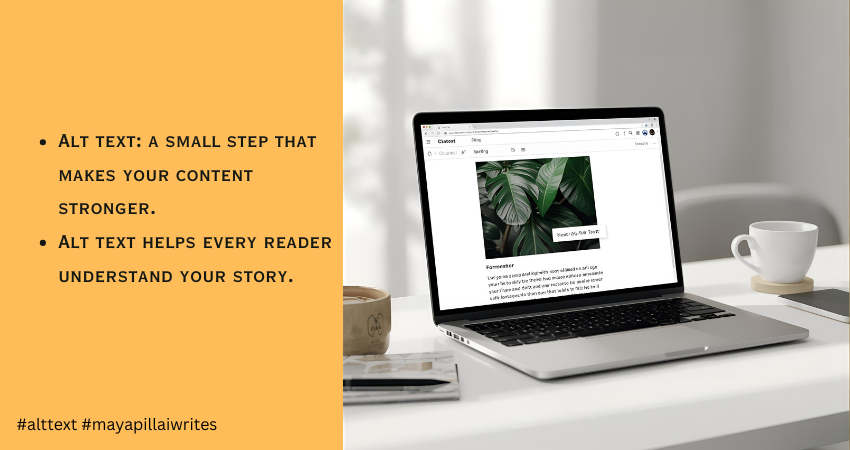
When you upload an image to your blog, you’re adding more than a visual break. You’re adding something that readers and search engines depend on to understand your content. Every image carries meaning, and when that meaning isn’t described properly, part of your message gets lost. This is where alt text becomes essential. It gives context to people who rely on screen readers and helps them follow your content without missing anything. It also helps search engines understand what the image shows, which improves your SEO. I didn’t pay much attention to alt text when I first started writing. I learned its importance much later, and it changed the way I publish my work. That’s why I want to share this with other writers, so they don’t overlook something so simple yet so helpful. Many bloggers skip alt text or add something vague, but good alt text for images makes your blog more accessible, more readable, and far more search-friendly. This article is for bloggers, writers, content creators, and website owners who want to make their content accessible, readable, and search-friendly through better alt text. TL;DR Alt text is a short description that explains what an image shows. It helps people using screen readers and improves SEO by giving search engines the context they need. Keep it short, clear, and natural. Avoid keyword stuffing. Skip decorative images. Good alt text makes your blog accessible and easy to understand. What Is Alt Text Alt text is a brief description added to an image. It appears when the image doesn’t load and is read aloud by screen readers. Search engines also use it to understand what the image contains. So alt text supports two important things at once: accessibility and SEO. Since search engines cannot interpret visuals the way humans do, they depend on image alt text to understand context. This helps your images rank better and increases the chances of appearing in Google Image Search. That’s why alt text is important. It links directly to visibility and inclusivity. How Alt Text Improves Accessibility Alt text plays a big role in accessibility because people with visual impairments or low vision rely on screen readers to browse the web. When a screen reader reaches an image, it reads the alt text aloud. If the alt text is missing, the tool either skips the image or reads a file name like “IMG_0243.jpg”, which offers nothing useful. Clear alt text accessibility helps these readers follow your content without missing any context. It gives them the same understanding that sighted users get at a glance. The description doesn’t need to be long. It only needs to explain the one thing that matters about the image. Good alt text creates a smoother reading experience. It fills the gaps when users can’t see the visuals and keeps your content inclusive for everyone. The SEO Benefits of Alt Text Search engines depend heavily on alt text to understand what an image shows. They can’t interpret visuals the way people do, so a clear description helps Google match your image with the right searches. When your alt text is accurate, Google gets a better sense of what the page is about. This makes your content easier to index and increases the chances of your images appearing in search results, which can bring in steady, organic traffic over time. Websites often see a noticeable improvement in search visibility when they use descriptive and consistent alt text. It gives Google the context it needs and helps the algorithm understand how each image supports the main topic of the page. Two main SEO benefits of alt text stand out: Better indexing and stronger page relevance Higher visibility in Google Image Search, which can attract new readers Good alt text works quietly in the background, but it strengthens your overall SEO more than most people realize. What Makes Good Alt Text Good alt text is clear, short, and meaningful. Follow these basics: Describe the main idea of the image Keep it under 125 characters because many screen readers stop reading after that Avoid phrases like “image of” or “picture of” Add purpose only if the image supports the point you’re making Use keywords only if they feel natural Make sure the alt text matches the context of the article, not just the image alone Example: If your article is about phishing, and you have an image of a laptop, you can adjust the description to match the topic. General alt text: “A person using a laptop at a desk” Contextual alt text: “A person checking a phishing alert on a laptop screen” Context improves relevance and SEO. Common Mistakes to Avoid 1. Skipping Alt Text Completely Screen readers can’t describe the image, and Google gets no information. It harms accessibility and SEO together. 2. Keyword Stuffing Forcing keywords into alt text makes it sound unnatural and confusing. It also weakens search relevance. 3. Writing Vague or Useless Descriptions “Nice picture” or “photo” adds nothing. Alt text should explain the purpose of the image. 4. Describing Decorative Images If the image is decorative or adds no meaning, leave the alt attribute empty (alt=””). This helps screen readers skip it. 5. Over-Describing the Image Long, detailed explanations interrupt readability. Alt text should offer only what the user must know. 6. Using File Names or Auto-Generated Text Never use “IMG_1543.jpg” or “screenshot_01.png”. Replace it with a real description. 7. Adding Alt Text When the Image Is Already Fully Described Nearby If your paragraph already explains what the image shows, adding the same text again in alt text becomes redundant. Screen reader users end up hearing it twice. How to Write Alt Text for Different Types of Images Photos Describe the main subject. Example: “A woman reading a book at a desk.” Infographics Share the key message. Example: “Infographic showing phishing attacks rising from 2023 to 2025.” Screenshots Explain what the screen displays. Example: “Screenshot of Gmail showing a security alert message.” Charts and Graphs
Headings That Work: A Simple Guide for Writers and Bloggers

When I began writing online, I didn’t think much about heading levels. I used them wherever they looked nice or helped break up long text. But when I started publishing regularly and tracking how readers behaved on my blogs, I noticed a clear pattern. Posts with well-structured headings always performed better. People stayed longer, skimmed less, and understood my message faster. Over time, I realized headings do more than make text look neat. They guide your reader’s eyes, tell search engines what your article is about, and even help you think clearly while writing. Once I started treating headings as part of the storytelling process instead of simple formatting, my writing became easier, sharper, and more engaging. If you’ve ever felt your article lacks flow or looks messy no matter how good the content is, your headings might be the missing link. TL;DR Headings are not just for decoration — they’re the structure of your content. Used properly, heading levels (H1, H2, H3) make your writing easier to read, improve SEO, and help you stay organized. A clear heading hierarchy boosts readability, search visibility, and reader engagement — all without adding more words. What Are Heading Levels and Why They Exist Every blog or article follows a hierarchy of headings — H1, H2, H3, and beyond. Think of them like a table of contents that lives right inside your post. Each heading tag has a job: H1: The main title of your post. Use it once. It’s what both readers and search engines see first. H2: Main sections or topics that divide your content into clear parts. H3: Subtopics under each H2 — these help explain, list, or expand a single idea. H4–H6: Rarely needed but helpful in long or technical guides for finer detail. This hierarchy tells Google how your content is structured and helps readers quickly jump to what they care about. Without it, even the best-written article feels like one endless scroll of text. Why Heading Levels are Important Now More Than Ever Headings aren’t optional — they define how readable, searchable, and trustworthy your content feels. Let’s look at why they matter so much for both readers and writers. 1. They Make Your Blog Easier to Read Most readers don’t read word-for-word. They scan. Headings act as visual cues that guide their eyes across the page. When your H2s summarize each section well, readers can instantly decide what they want to read in depth. Imagine someone lands on your blog looking for “how to write blog introductions.” If your headings look like this: H2: Why Introductions Matter H2: Common Mistakes Writers Make H2: How to Hook Readers from the Start H3: Use a Relatable Example H3: Ask a Simple Question H3: End with a Smooth Transition They’ll immediately see that your post answers their exact question — and stay longer to read it. Readable headings reduce bounce rates, improve engagement, and give your article a natural flow. Each section feels complete and self-contained, making it easier for readers to pause and resume later without losing track. 2. They Improve SEO and Ranking Search engines rely on headings to understand your content. When your H1 includes your focus keyword and your H2s reinforce related ideas naturally, you’re telling Google exactly what your article covers. For example, if your main keyword is “content writing structure”, your headings could look like: H1: Content Writing Structure: A Complete Guide for Beginners H2: Why Structure Matters in Writing H2: Key Elements of a Well-Structured Blog H3: Using Headings and Subheadings H3: The Role of Formatting in Readability This structure helps your blog rank for both the primary keyword and related searches. Search engines also use headings to generate featured snippets, AI cards, and voice search results. Well-formatted content gives them clear sections to pull from — increasing your visibility without extra optimization tricks. The key is balance. Don’t stuff keywords into every heading. Use them where they make sense. Your goal is clarity, not clutter. 3. They Support AI Search and Voice Results AI-driven search (like Google’s SGE or Bing Copilot) doesn’t just read keywords — it reads structure. Headings help AI models understand relationships between topics, questions, and answers in your article. For example, if your H2 says “How Headings Improve SEO” and your H3 says “Why Google Prioritizes Structured Content,” you’re creating a clear logical flow. AI can then extract those sections as concise, ready-to-display responses for search queries. This structure is also useful for voice search. When someone asks, “Why are headings important in writing?” your clearly labeled section might be exactly what gets read out loud. 4. They Make Your Content Accessible Headings play a big role in accessibility. Screen readers use them to help visually impaired users navigate through a page. Proper heading hierarchy allows users to skip to sections they want instead of listening to the entire article line by line. If you rely only on bold text or large fonts instead of actual heading tags, screen readers can’t recognize the structure. That means a part of your audience might never be able to read your content properly. Accessibility isn’t just about compliance — it’s about respect for your readers. Using proper heading levels ensures everyone can enjoy and learn from your writing. 5. They Keep You Organized as a Writer Headings don’t just make your article easier to read — they make it easier to write. When you outline your H2s and H3s before writing, you’re building a roadmap for your article. Each heading acts as a checkpoint, helping you stay focused and move logically from one idea to the next. This approach also removes the stress of starting with a blank page. Once your headings are ready, all you have to do is fill in the sections. You know exactly what each part should cover, so you spend less time second-guessing what comes next. Good headings also help you see patterns. If two sections sound too similar, you’ll know it’s time to merge
How Important Are FAQs in Any Blog
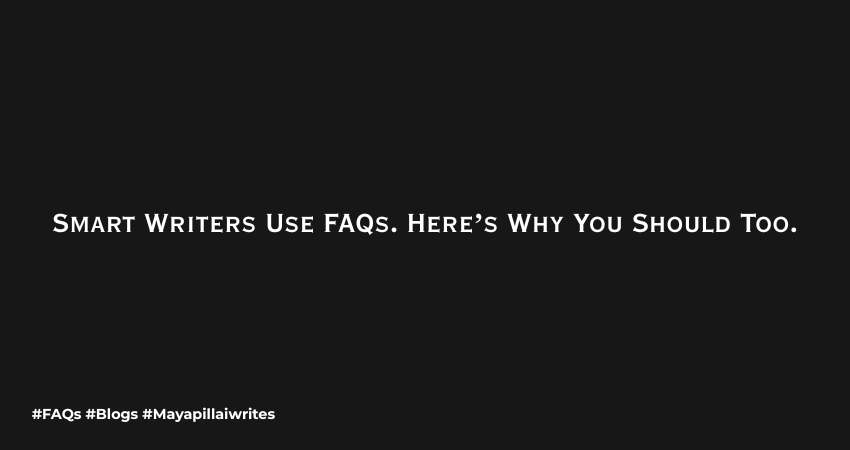
As a content writer, I’ve noticed that many people underestimate the power of a simple FAQ section. It’s often seen as something meant for corporate sites, not personal blogs or creative pages. But from experience — both here on MayaPillaiWrites and on my cybersecurity platform, The Review Hive — I’ve seen how adding FAQs improves visibility, boosts engagement, and helps content rank better. Today, Google’s AI-driven search experience rewards content that answers user intent clearly. Blogs with well-structured FAQs are more likely to appear in “People Also Ask” boxes and AI summaries. That’s why FAQs aren’t just nice to have anymore — they’re essential for keeping your content visible and relevant in 2025 and beyond. When I first started adding FAQs to my posts, I noticed two big changes: readers stayed longer, and some of my articles started showing up in “People Also Ask” boxes on Google. That’s when I realized how much value a few well-structured questions can bring to a piece. TL;DR Google’s AI-powered search now favors content that directly answers user intent. Adding FAQs at the end of a blog helps your post rank higher, appear in featured snippets, and show up in AI summaries. FAQs make your content more readable, trustworthy, and complete while keeping it fresh with quick updates. Whether you write for readers or for search, FAQs now play a key role in visibility and engagement. Top 10 Reasons Why You Should include Faqs in Your Blogs or Articles You’ve probably seen FAQ sections at the end of many blogs, but have you ever thought about why they matter? For most readers, FAQs are where clarity meets curiosity. They help answer quick questions, improve how Google understands your content, and make your post feel more complete. Here are the top ten reasons why every writer should include FAQs in their blogs or articles. 1. Helps You Rank for More Search Queries Every FAQ question is a keyword opportunity. When you phrase your questions the way real people search, you naturally cover long-tail keywords your main post might miss. For instance, if your article is about phishing scams, an FAQ like “How can I tell if an email is a phishing attempt?” helps you appear in more specific search results. Over time, this approach strengthens your topical authority and improves your overall search performance. It’s also easier for Google to understand your content because FAQs mimic natural, conversational search patterns — something that’s becoming more important with AI-driven search. 2. Boosts Featured Snippet and SGE Visibility Google often highlights FAQ answers in People Also Ask sections or AI-powered snippets. When your answers are short, clear, and factual, they’re more likely to be featured in Search Generative Experience (SGE) results. For example, a well-written FAQ such as “What are the best practices for writing SEO blogs?” might get pulled directly into a Google answer card. This not only increases your visibility but also makes your blog look credible to readers who see your site as a reliable source of information before even clicking. 3. Makes Your Content Easier to Read Not everyone has time to read long paragraphs. Many readers skim, especially on mobile devices. An FAQ section gives them quick, direct answers in an easy-to-scan format. For example, if someone visits your blog post about writing listicles, they might scroll to the end and immediately find “How long should a listicle be?” or “Do odd or even numbers work better?” When readers can find information fast, they stay longer, share your post more often, and associate your site with clarity and usefulness. 4. Builds Credibility and Trust Answering common questions shows that you understand your audience’s pain points and that you’ve put thought into solving them. For example, if you’re writing for freelance writers, including questions like “How can I find high-paying writing clients?” shows that you know what your readers are struggling with. This positions you as an expert who’s approachable, not robotic. It builds credibility and creates a sense of connection — a key part of why people keep returning to the same blogs. 5. Supports Voice Search Optimization Voice search queries are usually conversational, like “What’s the best way to write SEO content?” or “How do I improve my blog’s visibility?” FAQs written in that same natural tone make it easier for voice assistants to pick your content. This can help your blog show up when people use smart speakers or mobile voice commands. For example, if you include an FAQ like “What are FAQs in blogs?” your answer might be read aloud by Google Assistant when someone asks that exact question. It’s an effortless way to future-proof your writing for how people are actually searching today. 6. Reduces Repetitive Inquiries FAQs save time by answering repetitive questions before they’re even asked. If you run a writing service, for example, you might often get asked, “Do you charge per word or per project?” or “Can you help with SEO optimization too?” Adding these to your FAQ section means readers get immediate clarity, and you spend less time replying to the same questions in DMs or emails. It’s also a professional touch that makes your website look well thought out and user-friendly. 7. Lets You Refresh Content Easily FAQs make it easy to keep your blog up-to-date without rewriting everything. When new tools, industry changes, or best practices emerge, you can simply add or modify a question. For instance, if Google changes its SEO algorithm or introduces a new feature like SGE updates, you can add a question like “How do Google’s AI updates affect blog SEO?” This quick update keeps your content current and tells search engines your page is active — which helps maintain ranking and credibility over time. 8. Increases Conversions (for Service or Business Pages) For service-based sites, FAQs can gently move readers toward taking action. They clear up doubts that often hold people back. For example, if someone is thinking about hiring a content writer, an FAQ
Content Writing Trends 2026: How User Intent Shapes the Future of Writing

In 2026, content writing is no longer about stuffing keywords or chasing algorithms. The real shift lies in understanding user intent and search intent. These two ideas define how readers find, read, and trust your work. The top content writing trends 2026 focus on writing with purpose, clarity, and empathy while adapting to AI-driven search results and generative summaries. Who This Article Is For This article is for freelance writers, bloggers, content strategists, and digital marketers who want to stay ahead in 2026. If you write blogs, plan content calendars, or manage SEO, this guide will help you understand how intent-driven writing can improve visibility, engagement, and credibility. Reading this will help you learn how to match what people search for with what they actually want to read — the core of future-ready content. The future of content writing in 2026 revolves around understanding user intent, adapting to AI-driven search, and blending creativity with data. Writers who focus on why readers search, not just what they search, will stand out. The Shift: From Keywords to Intent For years, SEO revolved around keywords. Writers optimized headlines and meta tags to match search phrases. But 2026 marks a shift — search intent and user intent now matter more than keyword frequency. Search engines and AI models understand the “why” behind a query. Are users seeking quick information, comparison, or an in-depth answer? Writers who match that intent create content that not only ranks but also gets surfaced in Generative Search Experiences (GSE). If someone searches “best AI writing tools,” their intent might be transactional (ready to buy) or informational (looking to compare). Recognizing this difference changes how you write the intro, tone, and structure. What Are User Intent and Search Intent User intent is the reason someone types a query into a search engine. It answers why they’re searching — to learn, compare, solve, or buy something. Search intent is how that purpose appears in search behavior. It’s what Google or an AI engine interprets when showing results. For example: “What is content writing” shows informational intent — the user wants to understand. “Best freelance content writers near me” shows transactional intent — the user is ready to take action. Understanding both helps writers shape tone, format, and structure. A post written for informational intent should teach clearly. A post for transactional intent should include solutions, pricing, or calls to action. When your content matches intent, it not only ranks higher but also keeps readers on your page longer — which boosts credibility and SEO. 8 Content Trends to Lookout For in 2026 Writing for Intent, Not Just Traffic In 2026, good writing means anticipating reader expectations. Each piece must serve a purpose; solve a problem, answer a question, or guide a decision. Three main types of intent: Informational: Users want to learn (example: “What is Generative Engine Optimization?”). Navigational: They’re finding a brand or website (example: “Maya Pillai Writes blog”). Transactional: They’re ready to take action (example: “Hire a freelance content writer in India”). Before writing, define which intent your post serves. Then structure your headings, tone, and CTAs around it. AI as a Writing Partner AI is an incredible co-writer in 2026, helping writers understand search patterns and intent gaps. It can suggest structure and keywords, but human creativity still leads. Writers use AI tools to analyze which topics match real user needs and then write with empathy and voice. AI helps with clarity; you bring the context. Use it for: Draft outlines from intent-based prompts (“write a guide for beginners” vs “write comparison for experts”). Summaries optimized for voice search or generative snippets. Generative Engine Optimization (GEO) GEO is the evolution of SEO. Instead of ranking high on search pages, you’re aiming to be cited or summarized in AI-powered search responses. To succeed in GEO, content must be clear, structured, and aligned with intent. A simple, human explanation often performs better than keyword-heavy text. When someone asks “how to write for user intent,” AI search tools will quote concise, trustworthy paragraphs that sound conversational. What helps: Direct answers under subheadings Bullet points for clarity Questions as headers for AI comprehension Dual Content Format: Deep vs Quick Readers have split attention. They want instant answers and deeper insights. That means balancing short-form content for discovery with long-form for authority. Short posts capture curiosity. Long-form builds expertise and trust. A content writer who can write both is more valuable than one who focuses only on one format. Create layered content — a quick summary on social media that leads to an in-depth post on your blog. Personalization Based on Intent Personalization now depends on where the user is in their journey, not just demographics. Someone exploring a topic for the first time doesn’t need expert jargon. Write for stages: Awareness: Keep it simple, relatable, and educational. Consideration: Add comparisons, statistics, and credibility. Decision: Include examples, testimonials, or CTAs. This approach improves user engagement and matches search engine expectations for high-intent relevance. Thought Leadership: The Return of the Human Voice In a sea of AI-generated content, an authentic voice stands out. Readers can sense when something is written with experience versus algorithmic filler. Share what you’ve learned. Use real examples. Admit mistakes. That’s how trust builds — especially in niches like content strategy or cybersecurity where credibility matters. Multi-Format Content for Search Diversity 2026 rewards content that exists in multiple forms — articles, videos, podcasts, and carousels. Voice search and visual summaries are driving visibility. Writers need to repurpose intelligently: Blog → audio summary → LinkedIn carousel Long-form → newsletter takeaway → 30-second reel Each version can serve a different user intent. For example, someone scrolling social media might just want a tip, not a full tutorial. Transparency Builds Trust Readers want to know how content is made. Being open about using AI tools or referencing data creates credibility. Include short disclosures like “AI-assisted, human-edited.” Use citations, add author bios, and list your sources. Trust signals now impact ranking and reader
What Not to Write in Listicles
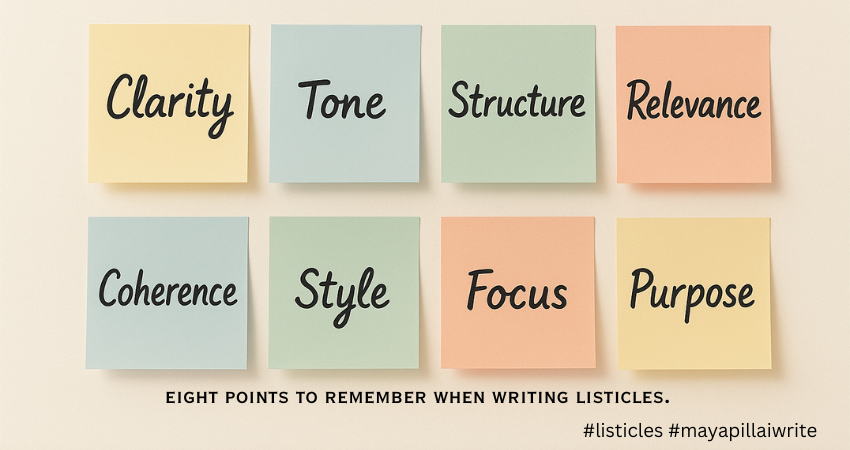
Writing listicles isn’t just about numbering ideas. It’s about structure, clarity, and value. This guide covers eight simple things to remember when writing listicles so your content stays readable, engaging, and relevant — without the fluff or repetition that turns readers away.
How to Optimize Anchor Text for SEO
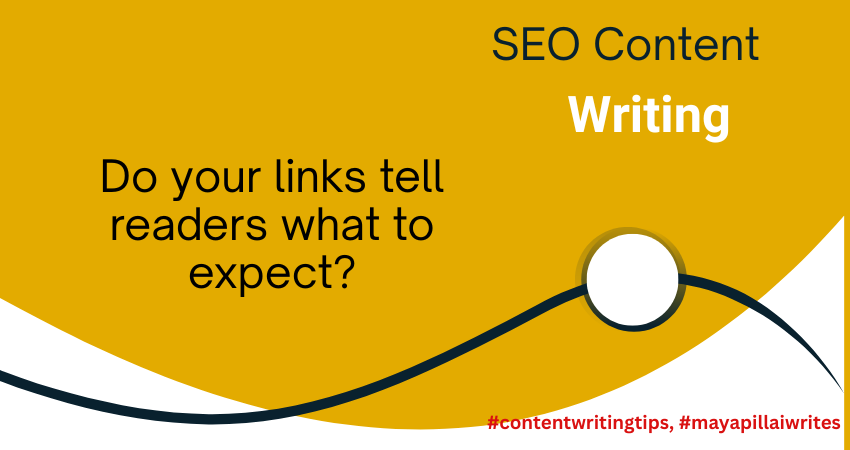
If you write online, you’ve probably added links to your articles. But the words you choose for those links — known as anchor text — matter more than most you realize. Anchor text is the clickable part of a hyperlink, and it tells both readers and search engines what to expect on the other side. When done right, anchor text improves SEO, makes your writing more reader-friendly, and helps your content rank. When done poorly, it can confuse readers and even lower your site’s visibility. In this article, you’ll learn how to optimize anchor text for SEO in a way that feels natural and easy to apply to your writing. This article is written from the writer’s perspective than from that of a SEO person. TLDR Anchor text is the clickable text in a link, and optimizing it improves SEO, readability, and user experience. Use descriptive and natural phrases, vary your wording, and link contextually within your content. Internal linking optimization keeps your site connected, while backlink anchor text builds authority. Regular anchor text audits ensure balance, and scaling practices help writers maintain consistency. Importance of an Anchor Text Anchor text SEO isn’t about tricking Google. It’s about being clear and helpful. If you use vague anchors like “click here” or “read more,” readers don’t know what they’re clicking on. If you stuff keywords into every link, it looks spammy and unnatural. If you use descriptive, natural anchor text, readers get value and search engines understand your content better. For writers, anchor text SEO is a skill that makes your work look more professional and improves discoverability. Internal Linking Optimization Internal linking optimization is linking between your own blog posts, portfolio pieces, or website pages. It keeps readers exploring your work and helps search engines connect your content. Match the anchor to the page topic If you wrote a guide on building a freelance portfolio, don’t just link with “portfolio.” Instead, use how to create a freelance writing portfolio. It signals exactly what the reader will get. Be descriptive, not vague Instead of “read more,” write anchors like learn how to optimize anchor text. Descriptive anchors improve trust and clicks. Use natural variations If you always link with the same phrase, it feels robotic. For example, mix backlink anchor text, anchor text for backlinks, and how backlinks work. Variations make your writing more natural. Spread anchors across your site Don’t always use the same anchor for one post. Use different but related phrases so your content captures multiple search terms. Link from stronger posts If one of your articles ranks well, link from it to a new post using optimized anchor text. This passes authority and helps the new post grow. Keep links in-context A link inside a paragraph is more powerful than one in a sidebar or footer. Always link within sentences that flow naturally. Backlink Anchor Text Backlink anchor text is what other sites use when they link to you. As a writer, you can’t fully control this, but you can guide it. Don’t over-optimize If too many sites link to you with the exact phrase anchor text SEO, it looks unnatural. Balance it with branded and partial matches. Suggest variations when guest posting If you’re writing a guest blog, suggest multiple anchor options. For example: internal linking optimization tips, backlink anchor text explained, or anchor text SEO guide. Blend brand and keyword anchors For your own site, try combining your name or brand with keywords, like Maya Pillai’s guide to anchor text SEO. It makes the link authentic. Avoid spammy anchors Low-quality sites may link with irrelevant words. These can hurt your profile. If possible, ask for changes or ignore them. Closing Paragraph Optimizing anchor text isn’t about following rigid SEO tricks; it’s about writing with clarity and intention. As a writer, you’re already choosing words carefully for your audience. Anchor text SEO is simply another layer of that craft. When you use descriptive, natural anchors and apply internal linking optimization consistently, your writing not only flows better but also gains visibility. Over time, this small habit can turn into a powerful strategy that strengthens your content and helps you stand out online. FAQs What is anchor text SEO? Anchor text SEO is the practice of using clear, descriptive words for hyperlinks so that both readers and search engines understand the linked page. How to optimize anchor text without keyword stuffing? Focus on natural language. Use variations like partial matches, branded anchors, and related terms instead of repeating the same keyword every time. Why is internal linking optimization important for writers? Internal linking optimization connects your articles, helps readers explore your content, and passes authority to key pages, which boosts rankings. What is backlink anchor text and why does it matter? Backlink anchor text is the clickable text used by other websites when linking to your content. Natural and varied backlink anchors strengthen your SEO profile. How often should I do an anchor text audit? Running an anchor text audit every few months helps you spot overuse, irrelevant anchors, or spammy links. This keeps your profile balanced and trustworthy.
Finish vs Complete: What’s the Difference?

Riya, a school student, was writing her English assignment. She wrote, “I have to finish the form before tomorrow.” Her teacher circled the word finish and wrote in red, “Not correct here. Use complete.” Confused, Riya asked, “But aren’t they the same?” The professor explained, “You finish a meal or a movie. But you complete a form or an assignment. One is about reaching the end, the other is about fulfilling every requirement.” That small correction stuck with Riya. She realized that while finish and complete look similar, they aren’t always interchangeable. When learning English, some words look like twins. Finish and complete often confuse learners because they both suggest something has ended. But they’re not always interchangeable. The difference lies in the focus—finish highlights the act of ending, while complete stresses wholeness. Let’s break it down. TL;DR Finish means bringing an activity to an end. Complete means making something whole by doing all parts. Use finish for actions, and complete for tasks or requirements. What Does Finish Mean? Finish is about reaching the end of an activity. The focus is on stopping or wrapping up, not on covering every detail. Examples: I need to finish my lunch before the call. She finished the book last night. When will you finish painting the wall? In all these cases, the idea is that the action came to an end. What Does Complete Mean? Complete is about wholeness. It’s used when every part of something is done. It’s also more formal, often used in school, office, or official contexts. Examples: Please complete the form. (fill in all details) The project was completed on time. The puzzle is finally complete. Here, the focus is on nothing being missing. A Quick Comparison Table Aspect Finish Complete Meaning To bring something to an end To make something whole Focus Ending an action Fulfilling requirements Tone Informal, daily use More formal Example I need to finish my coffee I need to complete my homework Phrases with Finish Finish up – wrap something quickly. Finish off – bring to a definite end. Cross the finish line – reach the end of a race. Finish strong – end with energy or success. Example: She wants to finish strong in her exams. Phrases with Complete Complete set – all items included. Complete stranger – someone you don’t know at all. Complete control – full power or authority. Complete silence – absolute quiet. Example: There was complete silence in the hall. Practice Time Try filling in the blanks: She couldn’t __________ her essay because she ran out of time. I’ll call you after I __________ my work. Please __________ the registration form. He didn’t __________ the exam; he left two answers blank. Key Takeaway Use finish when you’re talking about ending an action. Use complete when you’re talking about fulfilling all parts of a task. Both words mean something is “done,” but the perspective matters. If you’re just stopping, use finish. If you’re making something whole, use complete. To Sum Up The words finish and complete may look alike, but they carry different shades of meaning. Finish is about bringing something to an end, while complete is about making sure every part is done. Understanding this difference can help you write and speak with more accuracy. Next time you pause before choosing between the two, ask yourself: Am I simply ending an action, or am I making something whole? The answer will guide you to the right word. 👉 Now it’s your turn: try writing two sentences of your own, one with finish and one with complete.
Common Mistakes to Avoid While Writing TL;DR

Readers today have short attention spans. They skim, scroll, and look for quick takeaways. That’s why TL;DR (Too Long; Didn’t Read) has become essential in blogs, newsletters, and even LinkedIn posts. A well-written TL;DR can pull readers in and help them grasp the main points without reading every word. But many writers get it wrong. A poorly crafted TL;DR can confuse readers or turn them away. If you’re new to the concept, you may want to read my earlier post on how to write a TL;DR before diving into the common mistakes people make. TL;DR (Why You Should Read) Keep it short and clear. Highlight the key takeaways, not the fluff. Use bullets or short sentences for easy scanning. Don’t add new points that aren’t in the article. Always place it where readers can see it. Top 10 Common Mistakes To Avoid Making It Too Long A TL;DR should act like a snapshot, not a second article. If it runs into paragraphs, it defeats its purpose. Limit it to three to five bullets or a short paragraph. The goal is clarity, not coverage. Being Too Vague Saying “This article is about writing better TL;DRs” isn’t useful. A TL;DR should summarize the main ideas. Think of it as answering: What will the reader walk away with? Avoid vague lines and focus on the specific lessons your article provides. Ignoring Structure Walls of text discourage readers. TL;DRs should be easy to scan. Use bullet points or crisp one-liners. Each point should stand on its own. For example, instead of “Summaries need clarity and keywords,” write: Keep sentences short. Use keywords naturally. 4. Leaving Out Key Points Some writers summarize only the introduction or conclusion, missing the middle. A good TL;DR should capture the most important insights across the whole article, not just one section. Overloading With Details Numbers, quotes, or side stories belong in the main article. The TL;DR is about the big picture. Don’t crowd it with examples or data. Focus on what matters most. Adding New Information Never use the TL;DR to sneak in new arguments, facts, or promotions. Readers expect a summary of what they’ve just read, not fresh material. Stick to what’s already in the post. Skipping Keywords If you’re writing for blogs, keywords matter. Forgetting them in your TL;DR is a missed chance to rank higher in search results. That’s why writers who understand why TL;DR in content is so powerful always pay attention to how it supports visibility as well as readability. Using Jargon Avoid industry-heavy terms or buzzwords that confuse readers. A TL;DR should be simple and accessible. Write it as if you’re explaining it to a friend who’s new to the topic. Forgetting the Reader Some TL;DRs read like notes for the writer. That’s not the goal. Always think: What would a new reader need to know in 30 seconds? Make the summary for them, not for you. Placing It in the Wrong Spot A TL;DR hidden at the end of the article often goes unread. Place it right after the opening paragraph, where readers can see it early. That way, they know what to expect and whether they want to read further. To Sum Up A TL;DR is a promise to your reader: “Here’s what you’ll gain without spending too much time.” If you keep it short, clear, and focused, it will build trust and encourage more people to read the full piece. Avoid the common mistakes—too long, too vague, or poorly placed—and your TL;DR will do what it’s meant to: make content easier to understand. And remember, a TL;DR isn’t just for articles. It’s tied to how you approach what is a blog in the first place. If your blog exists to serve readers, the summary should always honor their time. Key Takeaways TL;DRs work best when short, clear, and structured. Avoid vague summaries, jargon, or unnecessary details. Always reflect the article’s main points, not just one section. Use keywords to support SEO and SGE readiness. Position the TL;DR where it’s visible, ideally at the start. Quick FAQs Q1. How long should a TL;DR be? A TL;DR should be short—ideally three to five bullet points or a short paragraph. Q2. Where should I place a TL;DR in an article? Place it right after the introduction. Readers should see it before they decide whether to continue reading. Q3. Should I use keywords in a TL;DR? Yes. Keywords help your summary rank better and match search intent, but use them naturally. Q4. Can I use TL;DRs on social media? Absolutely. TL;DRs work well for LinkedIn, X, and Threads posts, where readers prefer quick takeaways. Q5. What’s the biggest mistake writers make with TL;DRs? The most common mistake is making it too long or too vague, which defeats the purpose.
How to Write a TL;DR
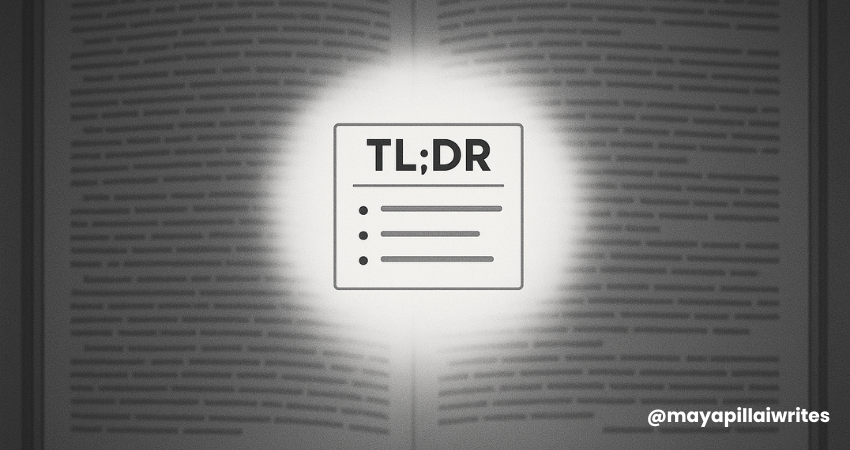
Most people don’t read every word on a page. According to the Nielsen Norman Group, users typically read only 20–28% of the text during an average visit. Add to this the reality that mobile readers scroll even faster, and you can see why summaries matter. A TL;DR (Too Long; Didn’t Read) gives readers the gist of your content in seconds. It keeps busy professionals from bouncing away and signals search engines that your article is structured, clear, and helpful. In the age of AI-powered search results and Google’s SGE (Search Generative Experience), TL;DRs have become even more powerful. They help your content get picked up for answer boxes, voice search, and AI-generated snippets. If you want your content to rank and resonate, you need a TL;DR that does more than summarize. It should hook readers, highlight value, and improve your visibility in search. Here are 10 practical tips on how to write a TL;DR that works for both people and algorithms. TL;DR Tips to Write TL;DR A TL;DR condenses your content into under 100 words. Write it last so it reflects the full piece. Use short sentences or bullets for clarity. Highlight reader value, not every detail. Place it near the top for maximum impact. Add focus keywords naturally for SEO and SGE. Match your article’s tone. Adapt TL;DRs for blogs, social, and reports. Test formats to see what performs better. Treat it as a hook, not an afterthought. Key Takeaways A TL;DR is not optional — it’s essential for both readers with short attention spans and search engines (especially AI-driven ones like Google SGE).Always write it last so it reflects the true essence of your content. Keep it short and direct — under 100 words, ideally 2–3 sentences or 3–5 bullets. Focus on reader value, not details — answer “what’s in it for me?” Use bullets or short sentences to make it scannable. Place the TL;DR near the top of the article, right after the intro. Add your focus keyword naturally for SEO and AI search visibility. Match the tone of your content so it feels consistent. Adapt it for platforms — bullets for blogs, conversational for LinkedIn, one-liners for Threads/X. Test and refine different formats; track engagement and adjust. Treat the TL;DR as a hook and pitch, not an afterthought. 10 Practical Tips to Write TL;DR 1. Write the TL;DR Last You need to understand your content fully before summarizing it. Writing the TL;DR after finishing your piece helps you capture the most important takeaways, not just what you think is important at the start. Think of it as writing the back-cover blurb of a book—you wouldn’t draft it before finishing the story. 2. Keep It Under 100 Words Readers want a quick grasp, not another mini-article. Aim for 2–3 sentences or 3–5 bullet points. Anything longer loses the “instant clarity” effect. On mobile, your TL;DR should fit on one screen without scrolling. Conciseness makes it powerful. 3. Focus on Reader Value Don’t summarize everything. Instead, answer the reader’s main question: What’s in it for me? Highlight the key outcomes, benefits, or lessons. If your blog is about writing productivity, your TL;DR should say, “These tips will help you write faster without losing quality” instead of simply stating that the article “lists productivity tools.” 4. Use Bullets for Clarity Bullets make TL;DRs easy to skim. They also break down points visually, so readers can digest them at a glance. If your article has multiple sections, bullets give structure without overwhelming. For long-form posts, this format is especially effective. 5. Place It at the Top A TL;DR works best right after your introduction. This is where readers decide whether to stay or leave. By placing it near the top, you show respect for their time and increase engagement. Search engines also give weight to summaries that appear early in the text. 6. Add Keywords Naturally For SEO and SGE, weave your focus keyword naturally into the TL;DR. For example, if your post is about how to write a TL;DR, make sure that phrase appears once in the summary. Don’t overstuff; keep it natural and conversational. Keywords here help search engines understand your content quickly. 7. Match the Tone of the Content If your article is casual, your TL;DR should be too. If it’s professional and research-driven, keep it crisp and precise. Consistency builds trust and makes the summary feel like an extension of the article, not a separate add-on. 8. Adapt It for Platforms Not every TL;DR looks the same. On a blog, bullets work well. On LinkedIn, you can expand it into 3–4 conversational sentences. On X (Twitter), shrink it into one sharp one-liner. By tailoring your TL;DR, you make your content reusable across platforms without feeling repetitive. 9. Test Different Formats Experiment with different styles—bullets vs. short paragraphs, one-line vs. multi-sentence. Check your analytics for scroll depth, bounce rate, and engagement. If your TL;DR is doing its job, you’ll see people spending more time on the page and scrolling deeper. If not, refine it until you find what resonates. 10. Treat It as a Hook, Not an Afterthought A TL;DR is more than a summary. It’s a pitch to convince readers your article is worth their time. Don’t tack it on quickly. Spend a few minutes refining it, because it may end up being the most-read part of your piece. Think of it as your first impression—make it count. Quick FAQs Q1. What is a TL;DR in writing? A TL;DR is a short summary that highlights the key points of an article, report, or post. It helps readers get the main message quickly without reading the entire text. Q2. How long should a TL;DR be? A TL;DR should be under 100 words. Keep it to 2–3 sentences or 3–5 bullet points so readers can understand it in seconds. Q3. Where should I place a TL;DR in a blog? Place your TL;DR near the top, usually after the introduction. This helps readers decide whether they want to
